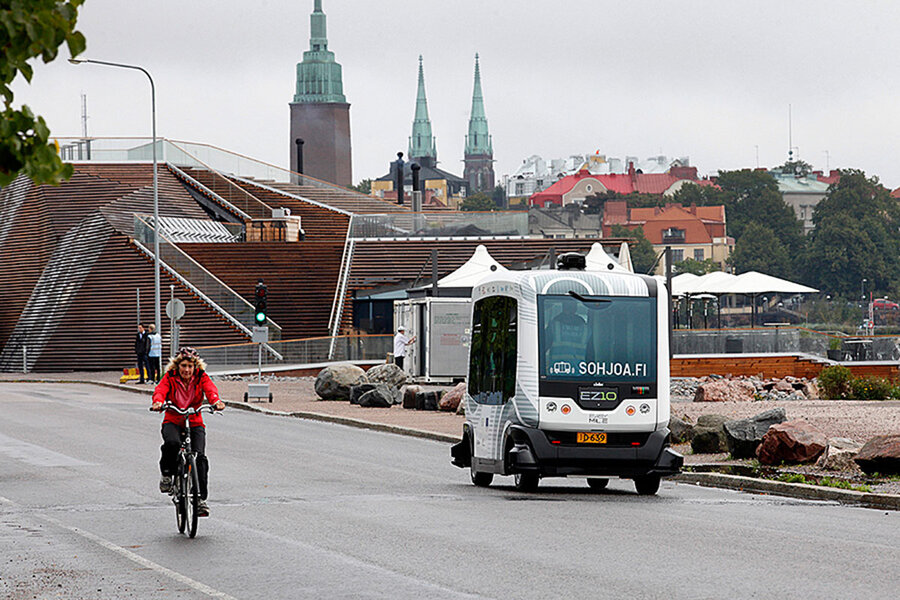An offer Finns can't refuse? Helsinki woos car owners to give up their autos.
Loading...
| Helsinki, Finland
For years, environmentalists and urban planners on both sides of the Atlantic have been fantasizing about few- or no-car city living, in order to make their municipalities easier and safer places to live, while also reducing their carbon footprint.
The mayors of a number of cities, such as Paris, Athens, and Mexico City, have committed their governments to banning cars by 2025. Others, such as Oslo and London, have imposed partial moratoriums and fees on city driving. But such bans are difficult to enforce and politically contentious.
In Helsinki, Finland, a city that prides itself on its civic-mindedness, municipal authorities are looking at the challenge of phasing out the car in a different way: as a matter of efficiency and incentivization.
“It is a fact that on average, a privately owned car is used 4 percent of the time,” says Ville Lehmuskoski, chief executive officer of Helsinki City Transport, the municipal body responsible for the Finnish capital’s public transport infrastructure. “The other 96 percent – the 96 percent of the time when it is parked there sitting around – represents an enormous loss of resources, particularly money and space.
“If the need for cars in the Helsinki region could be lessened by only 25 percent,” Mr. Lehmuskoski continues, “it would mean 100,000 fewer cars. If the average value of the car is €10,000 [$11,150], that would mean €1 billion [$1.1 billion] could be freed to speed up the economy in a more effective way, or otherwise benefit the society.”
Getting Greater Helsinki’s million-odd, peninsula-centered residents to view the privately owned car as an uneconomic investment of the region’s finite resources, rather than a matter of private convenience, is an offshoot of Finland’s social democratic history and experience.
“Helsinki has chosen a different strategy from other European cities,” says Marko Forsblom, chief executive officer of Intelligent Transport Systems, a Finnish transportation think tank. “It has chosen to create such good alternatives to the private car that people voluntarily choose other modes than owning a car. It has chosen to get people to look and think about their cars differently.”
Probably not an outright ban
The notion of banning cars in the Finnish capital is not new. The Green League, which consolidated its foothold as the second largest party in Helsinki in April’s city council election, openly supports such a ban. However, as the preponderance of voters who cast their ballots for the “pro-car” conservative National Coalition Party made clear, an outright ban is not in the works, at least for the moment.
That’s all right with Helsinki’s transportation community. “I don’t believe that cars in Finland or Helsinki will be banned,” says Lehmuskoski. “I believe that walking, cycling, and public transport will be more and more user-friendly so that competitiveness of passenger cars will decrease. Pricing of car traffic may also increase attractiveness of sustainable modes in the future.”
Anne Berner, Finnish minister of Transport and Communications, also discourages the notion that public transport and the private car are incompatible. “There has been a lot of discussion, including heated exchanges, in Helsinki about future transport policy and infrastructure choices,” says Ms. Berner. “But overall I would say that most people see public transport and private car use as complementing each other. Many people also acknowledge that to meet our strict emission targets and cut CO2 emissions, some changes are needed.”
Of course, letting go of the idea of owning a car is easier to do in a city that has one of the more efficient and popular metropolitan and regional transport systems in Europe. As any visitor to the Finnish capital can attest, Helsinki’s trams, subways, and buses are attractive, well maintained, efficient, and nearly always on time.
The proportion of Helsinki’s population using public transport reached a peak in 1966, when two-thirds of all Helsinkians’ journeys within the metropolitan area were via public transport. That share declined during the 1970s and ’80s as Finland rebounded from the war and more Finns were able to buy cars. Public transport’s share of total journeys bottomed out in 2008 at 42 percent.
Since then, its share has been rising again, a trend the city leaders are happy to encourage.
“I’m very satisfied with the quality of public transport,” says Heidi Silvennoinen, a young architect who lives in Otaniemi, a suburb of Helsinki. “I mostly travel from Otaniemi, which is 15 minutes away. Buses run every 10 minutes during rush hour and every half-hour during the rest of the day and until 5 in the morning.”
“With that level of convenience, why would I need to buy a car?” she adds.
Lessons from World War II and Nokia
Finland has a history of marshaling its spatial and economic resources and thinking out of the box. Witness the way Finland transformed itself from an agricultural society to an industrial-based one after the devastation of World War II. Or how Finns, led by Jorma Ollila, CEO of the telecom giant Nokia, ignited the telecommunications revolution of the 1990s – and helped power the country out of that decade’s economic depression.
Indeed, there is a direct connection between the thinking behind Nokia and the new “mobility as a service” (MaaS) philosophy that Helsinki is trying to bring to the challenge of phasing out the car. As Sampo Hietanen, CEO of MaaS Global, one of the start-ups behind the car rethink, points out, transportation and mobility “are commodities that we need to have to be in contact with each other.”
“I would argue that the potential for productivity gains in mobility will be the biggest driver for economic growth in the next few decades,” says Mr. Hietanen. “Eighty-five percent of the market value of a single-occupancy vehicle that is used 4 percent of the time.”
The ultimate objective of the MaaS “movement” is to provide residents of Helsinki with a range of options so cheap, flexible, and well coordinated that it becomes competitive with private car ownership, in terms of both cost and convenience. Subscribers to MaaS Global, which promotes itself as a “carefree, environmentally sound alternative to owning a car,” would specify an origin and a destination. The MaaS Global app would then function as both a journey planner and universal payment platform, fusing everything from driverless cars and buses to shared bikes and ferries into a “mesh” of mobility.
“It’s a different way of ‘connecting people,’ ” says Hietanen, referencing a former Nokia slogan.
As far as Berner, the minister of Transport, is concerned, this kind of innovative transportation thinking is a moral and environmental imperative for Finland, as well as an economic one. With the rapidly expanding capital’s arterial and ring roads congested with traffic, Finnish authorities are willing to try anything that has a realistic prospect of reducing the number of cars, while providing a similar level of convenience.
Transport planners already have a good “template” to work with, both in terms of the number of car-owning households and the quality of the current public transportation system. As Mr. Forsblom points out, “The fact is, today the majority of households in Helsinki – about 55 percent – are carless.”
“The importance of public transport has steadily grown in city planning,” says Pekka Sauri, Helsinki’s deputy mayor. As proof of the city’s commitment to public transport, Mr. Sauri cites the new multibillion-euro light rail line being built to connect several parts of Helsinki with the neighboring city of Espoo, as well as a fast bus line to connect the two metropolises.
Making it easier to ‘let go’
At the same time, officials are trying to make it easier for Helsinkians to let go of their cars – or at least their second cars – and switch to public transport by converting a number of the congested main roads into “city boulevards,” with lower speed limits and high-speed trams. They’re also widening walking areas in the city.
Sauri admits that enabling car mobility is low on his list of city mobility priorities. “The mobility priorities in city planning are, in descending order, walking, cycling, public transport, deliveries, and private cars,” says the longtime city manager.
Surprisingly, many car dealers are open to the government’s push to phase out, or at least deemphasize, the car. “I think it’s understandable that the government would wish to restrict or phase out the car if it is to fulfill its environmental directives,” says Tomi Riihimäki, CEO of Autocompany, a private high-end secondhand auto and boat dealership.
Mr. Riihimäki, who has been in the car business since the 1980s, confirms that attitudes toward car ownership among Helsinkians have changed, particularly among young people. “Many young people have given up driving,” he says. Nevertheless, he says business is good.
One thing he notices is that people are thinking more about what kind of car they want. He also has seen a surge in interest in electric cars, particularly among Millennials.
Riihimäki, who lives in Katajanokka, on the edge of the Helsinki peninsula, notes that he is an avid user of Helsinki’s public transport system. “I use public transport every time I can,” he says. “If anything, I would like to see the city institute more ferries to make better use of our water lines. After all, we are located on a cape.”
On-demand minibus service canceled
But Helsinki’s progress toward a brave new digitalized transport millennium has not been a straight line. Witness the city government’s decision to pull the plug on its much-heralded Kutsuplus. For a year and a half, the pioneering on-demand minibus service had allowed riders to choose their own route and summon a trip in real time with their smartphone.
Ajelo, a local tech start-up, developed the dispatch system, which was able to constantly adapt routes for each bus, aggregate user requests in real time, and calculate journeys to accommodate every passenger – in a sense, what MaaS purports to do. Helsinki Region Transport Authority managed the vehicles. But at the end of 2015, the new system, which charged more than a normal bus but less than a taxi, was abandoned because it required too much of a subsidy.
“It’s unfortunate that Kutsuplus didn’t pan out,” says Forsblom. “Nevertheless, it was a valuable experiment which resulted in a lot of new know-how and changed our thinking about the possibilities of on-demand driven transportation.”
This suits the Finnish government just fine. If Helsinki can serve as an incubator for new ideas in transportation that other countries can use, as it did with telecommunications in the ’90s, so much the better. In fact, the government sees the possibility of leveraging Finnish expertise in transportation into an exportable product that can help lift the country out of its current economic doldrums – just as Nokia did.
As Berner states optimistically, “We have the right ingredients to succeed at this, including the entrepreneurial energy and tech know-how. So hopefully we are seeing the birth of a thriving and exportable mobility ecosystem.”
Or as Forsblom puts it, “Our own domestic problems are rather small, but we’d like to use our experience and ideas to help other cities and societies find a better and more rational way of using their resources.”
After all, Finns figure, if they’ve shown the world how to connect one way, why not another?









